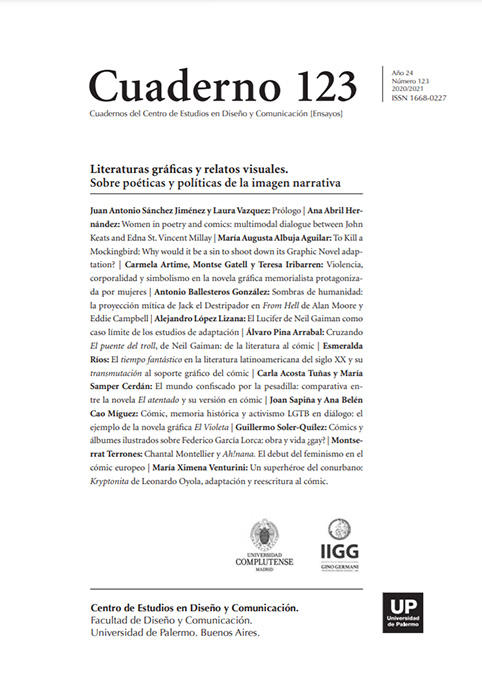El tiempo fantástico en la literatura latinoamericana del siglo XX y su transmutación al soporte gráfico del cómic
Abstract
This article proposes material support as a narrative structure based on the concept of literary chronotope –relationship between space-time with aesthetic intention in literature– by Mikhail Bakhtin, and the contrast with Latin American literature of the 20th century. Although the time in the graphic narrative is found in the visual representation of the space, analyzed by Linden, Barbieri, McCloud, among others, my premise is the way of time in such narrative really inhabits the blank spaces between frames or panels, and proposes the analysis of the support in the comic and the possibility of experimenting with it to deepen into the narrative discourse –while suggesting a classification based on its alteration–. The proposal is the transmutation of such white spaces into cuts, folds, unfolding and other resources that turned into an alternative format/support to get a different temporal perception in the reader, and likewise, give him the feeling of being co-creator of the story; in turn, such alteration of the conventional narrative support will translate into fantastic time. This conception of graphic supports can also influence new editorial schemes and a different kind of reader.
References
Bajtín, M. (1989). Las formas del tiempo y la novela. Madrid: Taurus.
Barbieri, D. (1993). Los lenguajes del cómic. Paidós.
Barrero, M., (2012). “De la viñeta a la novela gráfica. Un modelo para la comprensión de la historieta.” (Coord.) Peppino Barale, A.M. Narrativa gráfica. Los entresijos de la viñeta. México: Universidad Autónoma Metropolitana.
Bioy Casares, A. (2014). La invención de Morel. Alianza Editorial
__________. (2015). Historias fantásticas. Alianza Editorial.
Borges, J.L. (2000). Ficciones. De Bolsillo.
Borges, J.L. (2011). Historia de la eternidad. De Bolsillo.
Carrión, U. (2012). El arte nuevo de hacer libros. México: CONACULTA/Tumbona Ediciones.
Cid Jurado, A. T. (2006) “De la traducción intersemiótica a la competencia intersemiótica”. Versión 18. México: UAM, pp. 115-132.
Cortázar, J. (1959). El perseguidor. Buenos Aires: Panamericana.
Cortázar, J. (2014 a). Cuentos completos/1. México: Punto de lectura.
__________. (2014 b). Cuentos completos/2. México: Punto de lectura.
__________. (2016). Clases de Literatura. Berkeley, 1980. México: De Bolsillo.
__________. (2019). Rayuela. España: Real Academia Española/Alfaguara.
Eisner, W. (1994). El cómic y el arte secuencial. Barcelona: Norma Editorial.
Foster, H. (2001). El retorno a lo real: la vanguardia a finales del siglo. Trad. España: Akal.
Fuentes, C. (2012). Aura. México: Era.
Golden, A. (2010). Making Hanmade Books. New York: Lark.
Hawking, S., Mandilow, L. (2006). Brevísima Historia del Tiempo. España: Booket.
Indij, G. (2008). Sobre el tiempo. Buenos aires: La marca editora.
Lefevbre, H. (2013). La producción del espacio. Traducido por Martínez, E. Madrid: Capitán Swing Libros.
McCloud, S. (2006 a). Making Comics. New York: Harper Collins Publishers.
__________. (2006 b). Understanding Comics. New York: Harper Collins Publishers, 2006.
Pimentel, L.A. (2017). El relato en perspectiva. México, Siglo XXI.
Pintor Iranzo, I. (2017). Figuras del cómic: Forma, tiempo y narración secuencial. España: Aldea Global, 2017.
Renán, R. (2009) Los otros libros: Distintas opciones en el trabajo editorial. México: UNAM.
Ricouer, P. (2017). Tiempo y narración II: configuración del tiempo en el relato de ficción. México: Siglo XXI.
Roas, D. (2011). Tras los límites de lo real: Una definición de lo fantástico. España: Páginas de espuma.
Todorov, T. (2016). Introducción a la literatura fantástica. México: Ediciones Coyoacán.
Van Der Linden, S. (2015). Álbum [es]. Venezuela: Ediciones Ekaré.
Zavala, L. (2017). Principios de teoría narrativa. México: Naveluz, UNAM.
Los autores/as que publiquen en esta revista ceden los derechos de autor y de publicación a "Cuadernos del Centro de Estudios de Diseño y Comunicación", Aceptando el registro de su trabajo bajo una licencia de atribución de Creative Commons, que permite a terceros utilizar lo publicado siempre que de el crédito pertinente a los autores y a esta revista.


